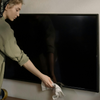How to Mount a Heavy TV on the Wall for Those Who Love a Big Screen

We’ve said it before and we’ll say it again, televisions have come a very long way since they were first invented in the late 1920s. From better picture quality to more and better facets such as incredibly realistic flat panel (or flatscreen) pixel quality or welcoming the introduction to more organized cable management opportunities by way of lighting cord or HDMI plugs, TVs have made lots of advancements.
One area, despite the evolution of TV screens getting to the point of being ultra slim, that can still be a difficult “thing” with TVs is the heaviness. Although you may not have an actual behemoth of a TV, like the Sony 34-Inch of the early 2000s that weighed a staggering 200 lbs, TV viewers still love to watch their favorite shows and teams on a TV that has a nice, big screen size, which often coincides with a heavy TV.
Yes, as mentioned, TVs are more streamlined with the flat screen TV look and feel, but the weight of a particularly big screen can still pose a challenge when transferring a TV to a different room, packing it up for a move across town, or even mounting a TV on the wall.
If you own a big screen TV that has a lot of weight to it, or you’re in the market for a new one, and you’re curious how best to mount a heavy duty TV (or, frankly, you have a heavy and large TV), what kind of equipment is needed and what type of mount you might need, read on! We have some answers for you as any TV-viewer should have the ability to watch a show, movie, or sports match at the viewing angle they desire, regardless of the weight of the TV.

Can You Mount a Heavy TV On a Wall?
The answer to this question is... it depends. Mounting any type of heavy TV up on the wall depends entirely on the strength of the wall to which you are mounting your television. If the wall you’re considering doesn’t have any studs, it’s better to be safe than sorry and to forgo mounting your heavy TV on the wall or, if you are capable and know what you’re doing, to use the appropriate anchor to support the TV’s weight.
For instance, toggle anchors and toggle bolts look like regular screws, but they come with a butterfly toggle at the end. When placed in the wall, the toggle anchors work by attaching to the back of the drywall. Pulling at the screw or applying some external force has little impact as the toggle causes the whole sheet of drywall to respond, rather than just the crumbly center.
On the other hand, screws are a dependable option great for hanging heavier items, like a full motion TV wall mount for a heavy TV, larger pieces of artwork, or a wall accessory like a hefty shelf. What you need to remember about screws though is that they should be drilled at least 1” into a stud.
Testing Your Stud Material
Not only do you need the right tools — such as the correct wall mount bracket, a drill, bolts, screws, and more than one set of hands — to safely install your TV to the wall, it’s also important to first test the strength of the studs and the wall before you begin the installation process.
First, figure out what type of studs your home has. If you live in a typical single family home, odds are your home has wooden studs. On the other hand, if you live in a high rise in a city or in a newer (possibly more “architectural” type home), your building likely has metal frames which require different tools and instructions for mounting anything to the wall (including pictures, mirrors, and TV mounts). Not sure the make of your studs? That’s okay, there are a number of ways you can test and plot the layout of the studs in your home.
Wood studs are typically heavier and can support more weight than metal studs. If you do have metal studs, however, there’s no need to despair, metal studs can still hold heavy objects if you use a bracket and mounting materials with the appropriate weight distribution for the item you’re hanging, whether that’s a TV wall mount for a heavy TV or a stunning, large piece of art.

Considerations for a Wall Mount for a Heavy TV
The first checkbox for when you’re looking to purchase a wall mount for a heavy TV is to guarantee the weight of the wall mount can sustain the weight of your television. If there is a discrepancy between the two, it’s best to continue looking for the ideal mount.
When it comes to MantelMount TV mounts, our mounts have a range for the amount of weight each mount can support. Our popular 540 Enhanced TV Mount has a weight capacity of 90 lbs with the TV dimension being at most 80” diagonal. If you’re looking for a more visual representation of what the MM540 has to withstand and the specifications, we have a handy spec guide.
If you have a slightly heavier television, our MM700 Premier Pull Down TV Mount has a weight capacity of 115lbs and the largest diagonal dimension at 90”. Is your heavy and larger flat screen TV used for movies, video games, and sports watching? If there is some weight that you can still add to the mount, even with the mounted TV, consider mount accessories that you’d like to incorporate to your viewing experience like a sound bar, a recess box, or a thin TV gap spacer.
Mounting a Heavy TV to a Wall Mount
How do you mount a heavy TV? Let’s just say, this is where a friend or family member will need to step in to help out. As mentioned, even though modern TVs may not be as heavy as the Sony 34-inch, flat screens are often top heavy.
While a person may be capable of lifting the TV on their own, balancing it by themselves can be kind of tricky. Think about it: if you’re looking to utilize a wall mount for a 60 inch TV (check the VESA pattern on the back of the TV for measuring!), it is going to be about 52 inches, or rather, a little over 4 feet. Therefore, we recommend having at least two people mount the TV and possibly a third to be the “director” to ensure the TV is not slanted or “off” while being attached to the mount’s wall plate.
If you decide to buy a MantelMount TV mount for your heavy TV, the process of hanging your mount on the wall is quite simple. We have installation guides and addendums at the ready for anyone who purchases one of our mounts. If you’re still struggling and using the guides, take a brief watch of this installation help video.
Regardless of installation guides and videos, you’ll want to make certain that you prepare the space around where you will be placing the wall mount, by not just finding the stud to use, but clean up the area so you have enough space to work with. Additionally, similar to removing a wall mount, have all of your tools and equipment readily available so the installation process is as simple as it can be.
Here are some of the tools you’ll need or want handy just in case...
- Painter’s tape
- Tape measure
- A level
- Concrete anchors and lag bolts — these items come in every MantelMount box
- Concrete screws and washers
- Drill with a hammer drill function
- Concrete drill bit
- Socket adapter, ratchet, or rubber mallet
Step 1. Locate the studs in your wall
The most efficient way to find studs in the wall is to use a stud finder. These can easily be purchased at your local hardware store or online. Once you have your stud finder, hold it to the wall you wish to use to display the TV. If the stud finder beeps while scanning the wall, this indicates there’s a stud under the drywall.
You can also test by knocking lightly along the wall with your knuckles to hear for any hollow spots — these are spots to avoid. Once you’ve confirmed you’ve found studs, mark the stud’s center with a pencil.
Step 2. Ensure your measurements are level
You’ll need to grab your helper(s) for this step. Once you’ve indicated where your pilot holes will be placed, have a friend or family member hold the bracket’s slats over the marks. Place your bubble level on top of the bracket and ensure it sits level. If not, you may need to adjust one of the pilot holes slightly up or down so your TV will be mounted straight. It’s important to verify this before drilling because once you start creating holes, it can be very difficult to troubleshoot without causing additional damage to the wall.
Step 3. Mark and drill your pilot holes
To properly mount your flat screen, you’ll have to create drill holes that are the correct size for your TV mount. Typically, a ¼” drill will work, but this can vary depending on the unique specs of your TV mount and the TV.
As the saying goes in sewing, “measure twice and cut once”. Remeasure your TV, the bracket, and the mount, and double check that the drill hole marks you’ve made on the wall line up with your television mount’s slats. When all of your measurements look correct, drill your holes into the studs.
Step 4. Attach your bracket to the wall and the TV to the bracket
Clear the drill dust out of your freshly-made pilot holes, add washers to the end of your screws, and secure the bracket to the wall through the bracket slats. Attach the TV mounting wall plate to the back of the TV and, with a partner, line up the TV mount with the bracket on the wall according to the manufacturer’s instructions.
Still feeling uncertain or uncomfortable about installing the wall mount for your heavy or large tv by yourself with the help of a friend)? MantelMount has professional installers ready for that purpose.






